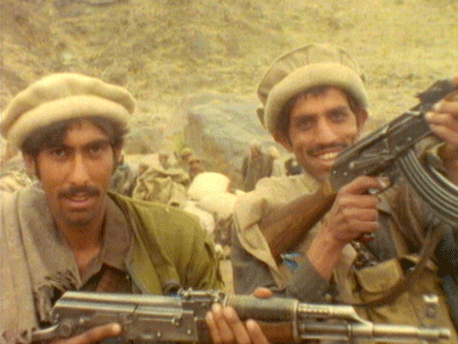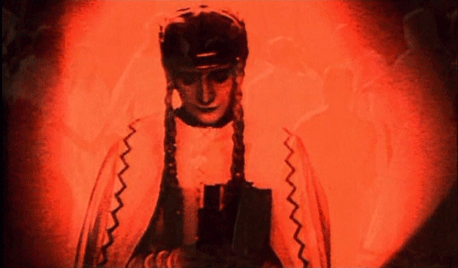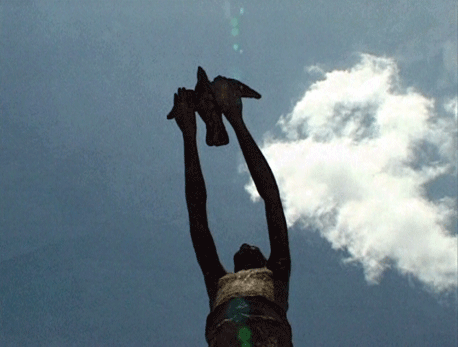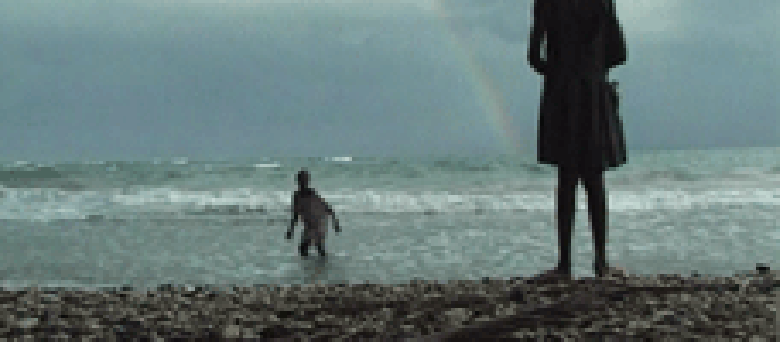Credits
Feature by: Tom Huddleston
Posted on: 20 August 2007
Related articles:
Features: ‘White Spaces on the Map’: An Interview with Richard Stanley
Reviews: Dust Devil (by Tom)
Reviews: Dust Devil (by Rumsey)
After his controversial dismissal from The Island of Doctor Moreau and subsequent banishment from polite filmmaking circles, director Richard Stanley wandered long in the wilderness, before finding a renewed calling as a documentarian. The earliest film in this collection, Voice of the Moon, was in fact completed around the same time as Stanley’s debut feature Hardware and depicts his travels around Afghanistan during the Russian retreat. But the latter two, The Secret Glory and The White Darkness, are far more recent, and along with his second and most personal feature, Dust Devil, they seem to pronounce an authorial voice for Stanley, dealing as they do with society’s ongoing need for myths, legends and folklore, and the equally beautiful and brutal consequences that can arise from such beliefs.
The story behind Voice of the Moon, as detailed in the impassioned interview that accompanies the film on Subversive’s recent DVD, would make a fascinating feature in itself. Stanley and his German cameraman Immo Horn left Britain in 1988, fleeing the cash-starved backwaters of the British film industry where Stanley had been miserable making music videos. They joined a UN relief mission to Afghanistan, but soon realised that, in such an official capacity, they were unlikely to visit anywhere unseen by Western eyes and the Western news media. So they jumped ship, enlisting with the Mujahedin and touring the country with their cameras, “getting stoned, eating walnuts and waiting to see what would happen.†But during the battle of Jalalabad in 1989 Horn was seriously injured, and Stanley was forced to abandon shooting and ship his friend across the border to safety. The film was completed the following year, just as his career as a feature filmmaker was beginning to take off, and was later donated to Unicef.

Voice of the Moon is short and essentially wordless, photographed on clockwork 16mm bolex cameras without synch sound, as most of Afghanistan was (and remains) without electricity. The editing is oblique and poetic, the only context provided by occasional titles giving sparse geographical information. But the images speak for themselves, building a narrative of sorts from the interweaving of disconnected footage. The story opens in a rural haven, a mountain village where we observe daily life and rituals. We follow Stanley and Horn’s journey, monitoring aid distribution in a famine-struck province, filming sporting events in celebration of the impending Russian departure, attending the attempted foundation of a new Afghan capital in a remote mountain town. Then the fighters are introduced, figures for whom Stanley clearly holds a great deal of respect and admiration. They are shown catching fish with dynamite, rolling in rusting tanks through the desert landscape, and finally succumbing to Russian rocket attacks on the outskirts of Jalalabad.
There are images in Voice of the Moon which resonate long after the film’s conclusion: sunrises and sunsets over the unforgiving ranges of the Kushkund mountains, tanks blasting fire and banks of rockets streaking the sky, the faces and lives of people never before (or since) photographed. Time lapse is used sparingly but to brilliant effect, tracking the movement of a creeping full moon, or the shifting patterns of light on a wall. The film is set to one of composer Simon Boswell’s most evocative scores, blending Dylanesque western themes and synthesised sounds with orchestral and traditional music, blurring the cultural boundaries in Stanley’s usual fascinating, if rather slapdash fashion.
The influence and impact of Voice of the Moon on Stanley’s later work, particularly Dust Devil, is obvious. The retreat of the Russian army here directly foreshadows the South African withdrawal from Namibia. Both films feature long, wordless passages of desert imagery: second unit photography on Dust Devil was even overseen by Immo Horn. The only narration in Voice of the Moon comes from a series of Sufic poems, lending the film a mythic, sacred quality, much as John Matshikiza’s folklorish voiceover does in the later film. There’s no direct reference to religion or myth in Voice of the Moon, but Stanley’s innate sense of naïve reverence permeates throughout.
This sense of quasi-religious wonder also infuses The Secret Glory, the longest, most complex and detailed documentary in this collection. As is often the case Stanley displays impeccably bad timing, working on a Holy Grail film about 18 months before Da Vinci Code fever took the world by storm, just long enough for the film to be shown at a few festivals and quickly forgotten. The director considers The Secret Glory unfinished, a work in progress complete with spelling and factual errors, and a really odd sound mix that requires even English speakers to be subtitled for fear the booming operatic score and rudimentary sound effects will drown them out.

This is not just another Grail story. Although marketed on the DVD as ‘a vision… of a grand quest’ reminiscent of those low budget DTV conspiracy documentaries one finds late at night on the History Channel, Stanley’s film is in fact far subtler. It examines the mysterious life and abrupt demise of Otto Rahn, a German poet and Grail scholar who joined the SS in the mid 1930’s, became a close confidant of Himmler, and was eventually shamed into an apparent suicide in 1939, on the eve of the 2nd World War. Taking in a potted history of the European esoteric tradition, the Albigensian massacres and the extermination of the Cathars and tying all this to Fascist ideology and 20th Century secret societies, the story is steeped in B movie imagery and conspiratorial mumbo jumbo.
But this is much more serious minded than the average historical shock-doc. There’s a lot of discussion in the film about how seriously Rahn took the Nazi ideology with which he became surrounded—some scholars are adamant that he was a dyed in the wool believer, as proven by his months of work at the Buchenwald concentration camp. Others attempt to make apologies for the man, insisting that he was simply doing as he was told, attempting to survive a terrible ordeal. Stanley refuses to draw concrete conclusions, though it’s clear he believes that Rahn’s suicide displays an appropriate level of repentance for sins either committed or unopposed.
Aesthetically the film is extraordinary, considering the presumably miniscule budget. Re-enactments of pagan rites and crucifixions were performed by French medieval revivalists, the stock treated in such a way that the footage looks like offcuts from some obscure turn of the century silent epic. Time lapse photography is again used to enchanting effect, particularly in scenes depicting the hilltop church at Montsegur, now a common destination for Grail hunters. Even the talking head footage is creatively mounted, with shadows and unnerving close ups used for dramatic effect. The subtitling is sometimes disconcerting: Stanley’s interviewees tend to rant, and one is so busy focussing on the words that the images are sometimes missed. The picture is grainy and inconsistent throughout, but this somehow lends an air of mystery, of an incomplete artefact somehow slipped into the public domain.
In his notes, Stanley describes how the original concept for the film sprung from a TV company’s desire to make a documentary entitled ‘The Real Raiders of the Lost Ark,’ and although the director’s focus shifted from the Ark to the Grail, there is a genuine sense of a pan-European adventure unfolding, for the filmmaker as well as for his characters. But this is a much darker vision of myth and history than anything Spielberg and Lucas could come up with. The Nazis of Stanley’s film are not the leering, scarfaced pantomime villains of fiction, but real people from living memory, whose obsession with aspects of legend and religious history made them all the more dangerous. In another excellent filmed interview, Stanley points out that most of the top Nazi leadership either claimed to receive visions or believed that they were, in fact, the reincarnation of some great Germanic figure—Heinrich I, Siegfried. This is the dark side of Stanley’s ongoing interest in mythos and folklore, when those myths begin to form part of the accepted cultural fabric, and the basis for very real and terrible crimes.
In The White Darkness, by contrast, it is a misunderstanding of myth which leads to tragedy. Commissioned by the BBC in 2000, the film is a record of Stanley’s investigation into the Haitian culture of voudou, and the numerous legends, lies and superstitions which surround that most maligned faith. Shot on grainy video and soundtracked with outtakes from Boswell’s Dust Devil score, The White Darkness is the loosest, most rough edged film in this collection.

It is also Stanley’s most directly political film. The central section uses interviews and historical footage to detail the interlocking histories of voudou and American intervention in Haiti, from the concentration camps and massacres of the early 20th Century to the army-supported Christian missions which now abound. Dismissing voudou as at best a child’s superstition, at worst a direct work of Satan himself, these missionaries and the soldiers who protect and sustain them treat the people of the island as little more than dangerous savages. The commander of US forces, Col. Walton Walker, was even removed from his position in Haiti following his interview with Stanley, in which he describes his mission as an act of faith, bringing the light of Christ to a godless populace.
By contrast, Stanley treats voudou as a misunderstood, essentially benign religion, using a combination of music, movement and ancient ritual to connect with spiritual truths. The opening and closing sections of the film depict, in a vivid, again almost wordless style, a series of intense voudou rituals, intercut with Horn’s magnificent natural landscape photography. But these sections of the film don’t work as well as their counterparts in Voice of the Moon or Dust Devil. Using video gives many of the images a thin, digitised quality at odds with the rustic setting. The interviews with voudou priests and believers start to seem repetitive, their attempts to explain their spiritual and emotional lives destined to fail. For voudou is perhaps the most alien of all religions, at least to Western eyes, a seemingly haphazard and ever evolving melange of African lore, Christian mythos and practical, power seeking application. It can mean, it seems, whatever its practitioners want it to mean.
The White Darkness is a strange, uneven film, displaying Stanley’s now familiar openness and borderline naïveté, but also a new, hard edged and confrontational style. His willingness to accept the word of these voudou priests and Emperors – who seem to these eyes almost as self serving and single minded as their Christian counterparts – tends to undermine the seriousness of Stanley’s subject. But his bullish persistence in confronting the brutal hypocrisy underlying the American occupation is laudable, and surprisingly hard-hitting. For the first time in Stanley’s work one feels a genuine, direct connection to the cruel realities of modern living, and a real sense of personal outrage: he’s dealt with similar issues before, but they have always been filtered through layers of poetry and metaphor, myth and misunderstanding. This time the anger is heartfelt and unavoidable.
These films and their accompanying interviews confirm Richard Stanley as a unique filmmaker—passionate, heartfelt, sometimes naïve but always honest, or at least adherent to his own particular vision of the world: unpredictable, wondrous and cruel but always strangely beautiful. They don’t feel like documentaries in the strictest sense of the word, ignoring the tenets of cinéma vérité in favour of a more emotive and poetic style, clearly the work of a storyteller rather than a fact seeker. For Stanley, truth lies somewhere beneath the surface, hidden from view, occasionally visible and then just as quickly gone.
We don’t do comments anymore, but you may contact us here or find us on Twitter or Facebook.



